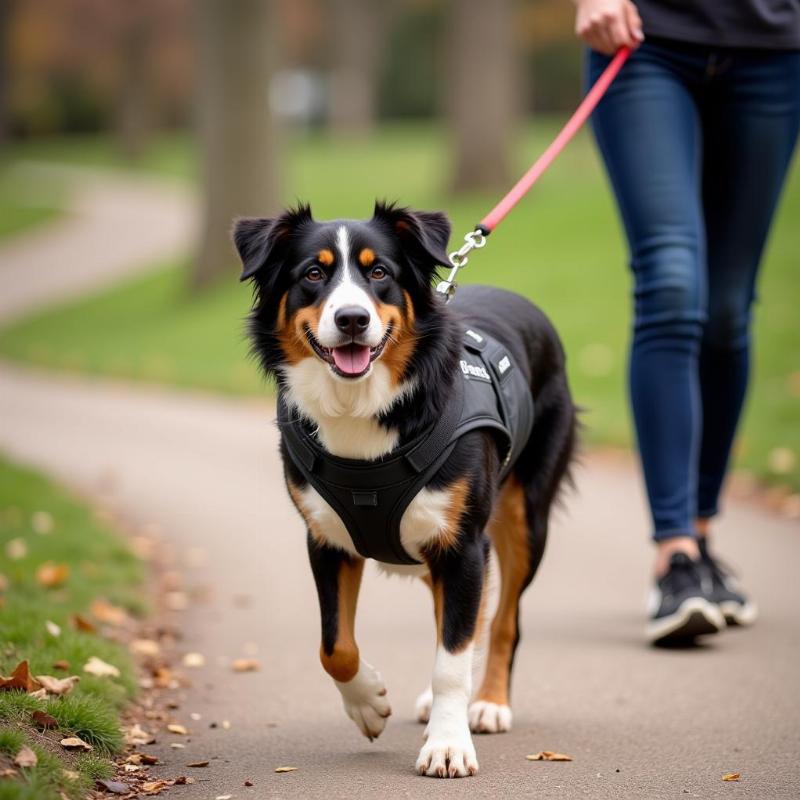Weighted vests for dogs are gaining popularity amongst pet owners seeking to enhance their canine companion’s physical conditioning. Whether you’re aiming for improved muscle mass, increased endurance, or simply a more structured exercise routine, understanding the proper use and benefits of a weighted vest is crucial. Choosing the right vest and implementing a safe training program will ensure your dog benefits from this tool without risking injury.
Understanding the Benefits of a Weighted Vest for Dogs
A weighted vest, when used correctly, can offer several benefits for your dog’s physical and mental well-being. It adds resistance to their movements, effectively strengthening muscles and building endurance. This can be particularly helpful for working dogs, sporting breeds, or dogs recovering from injuries. Beyond physical benefits, a weighted vest can also provide a calming effect for anxious or reactive dogs, offering a sense of security and reducing unwanted behaviors. Think of it as a gentle, constant hug that helps them feel grounded. However, it’s important to note that weighted vests aren’t a quick fix or a substitute for proper training and socialization.
Choosing the Right Weighted Vest for Your Dog
Selecting the appropriate vest is paramount for your dog’s safety and comfort. The vest should be evenly distributed across the dog’s body, preventing strain on specific areas. Adjustability is key, allowing you to customize the fit as your dog grows or changes muscle mass. Look for vests made from breathable, durable materials, ideally with reflective strips for enhanced visibility during walks, especially in low-light conditions. Consider the weight distribution and opt for vests with smaller weight increments, allowing for gradual progression and preventing overexertion. The American Kennel Club (AKC) offers resources on responsible dog ownership that can complement your research.
Implementing a Safe Training Program with a Weighted Vest
Introducing a weighted vest should be a gradual process. Start with a very low weight, no more than 5-10% of your dog’s body weight, and short training sessions. Closely monitor your dog for signs of fatigue or discomfort. Gradually increase the weight and duration of the sessions as your dog adapts. Avoid using the vest for high-impact activities like running or jumping, especially in the initial stages. Consult with your veterinarian before starting any new exercise program, especially if your dog has pre-existing health conditions.
 Dog Wearing a Weighted Vest on a Walk
Dog Wearing a Weighted Vest on a Walk
Common Mistakes to Avoid with Weighted Vests
Overloading your dog with too much weight too soon is a common mistake. This can lead to injuries and discourage your dog from exercising. Another mistake is leaving the vest on for extended periods outside of training sessions. This can restrict movement and cause discomfort. Finally, neglecting to properly fit the vest can lead to uneven weight distribution and potential injuries.
“Proper fit and gradual introduction are key to maximizing the benefits of a weighted vest while minimizing the risks,” says Dr. Emily Carter, DVM, a certified canine rehabilitation specialist.
Monitoring Your Dog’s Progress and Adjusting the Program
Regularly assess your dog’s response to the weighted vest training. Look for improvements in muscle tone, endurance, and overall physical condition. If your dog shows signs of fatigue, reduce the weight or shorten the sessions. Remember that consistency is crucial, but always prioritize your dog’s well-being over strict adherence to a training schedule.
Conclusion
A weighted vest can be a valuable tool for enhancing your dog’s fitness and addressing certain behavioral issues, but it’s crucial to prioritize safety and proper usage. By carefully selecting the right vest, implementing a gradual training program, and closely monitoring your dog’s response, you can ensure a positive and beneficial experience for your canine companion. Remember, consulting with your veterinarian is always recommended before starting any new exercise regimen.
FAQs
- How much weight should I add to my dog’s vest? Start with no more than 5-10% of your dog’s body weight and gradually increase as they adapt.
- Can puppies wear weighted vests? It’s generally not recommended to use weighted vests on puppies whose bones are still developing. Consult with your vet.
- What type of activities are suitable for weighted vest training? Controlled walks, short hikes, and obedience training are good options. Avoid high-impact activities.
- How long can my dog wear a weighted vest? Limit vest use to short training sessions and avoid leaving it on for extended periods outside of training.
- What are the signs of discomfort to watch out for? Excessive panting, lagging behind, reluctance to move, and changes in gait are signs your dog may be uncomfortable.
- Are there any breeds that shouldn’t wear weighted vests? Brachycephalic breeds (those with short noses) and dogs with respiratory issues may not be suitable candidates. Consult your vet.
- Can a weighted vest help with my dog’s anxiety? While a weighted vest can provide a calming effect, it should be used in conjunction with other behavior modification techniques.
“A weighted vest should be viewed as a tool to enhance training and not a solution in itself,” advises Dr. Mark Johnson, a certified professional dog trainer with over 20 years of experience.
Related Articles (if any found on beautdogs.us, please add the links here)
About Beautdogs.us
Beautdogs.us is your premier online resource for all things dog-related in the USA. We offer expert advice on dog breeds, care, training, and product reviews to help you provide the best possible life for your furry friend. Whether you’re a seasoned dog owner or just starting your journey, Beautdogs.us provides reliable, comprehensive, and engaging information to support your dog parenting journey. We are passionate about helping you navigate the world of canine companionship with confidence. Contact us at [email protected] or call +1 501-555-7529.